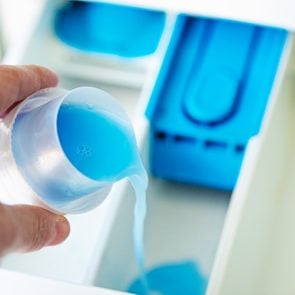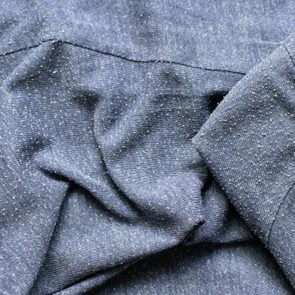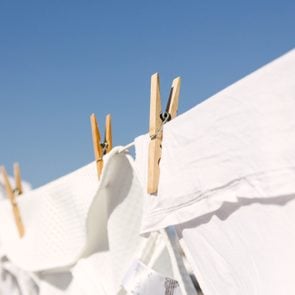Steamer vs. Iron: Which Is Better for Your Clothes?
Updated: Feb. 08, 2024
In the steamer vs. iron debate, the decision comes down to fabric. Here's everything you need to know about how to remove wrinkles from clothing, curtains and more.
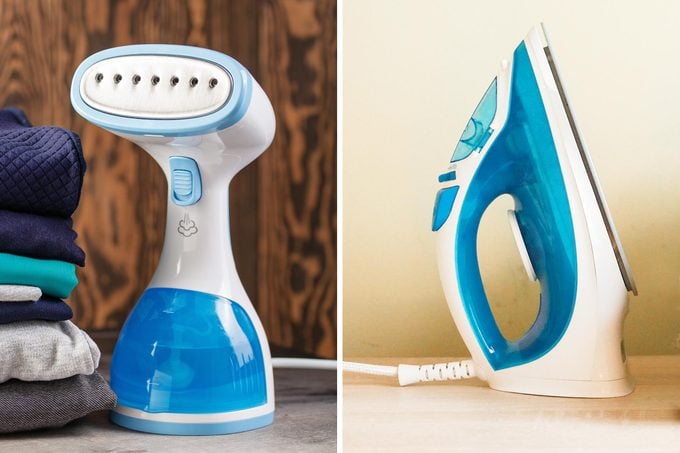
The other morning before work, I faced a classic problem. I went to put on my favorite linen shirt, only to find that it looked like it had been sitting at the bottom of the laundry pile for weeks. (Spoiler alert: It had.) The question was now how to get rid of the wrinkles—fast. When it came to using my steamer vs. iron, which would work best?
The answer lies not just in fabric type but in the delicate dance between heat, moisture and finesse, according to laundry experts. To find out what to do (though not that morning—I was already late for my train!), I consulted Mary Gagliardi, Clorox’s in-house scientist and laundry expert, and LaundryTok expert Melissa Dilkes Pateras, author of A Dirty Guide to a Clean Home. Their tips will help you figure out which trusty device is best for every fabric—and how to use them properly every time.
Get Reader’s Digest’s Read Up newsletter for more cleaning, tech, travel, humor and fun facts all week long.
About the experts
Reviewed for accuracy by: Mary Marlowe Leverette, a highly regarded fabric-care, stain-removal and housekeeping expert with more than 40 years of experience. |
When to use a steamer
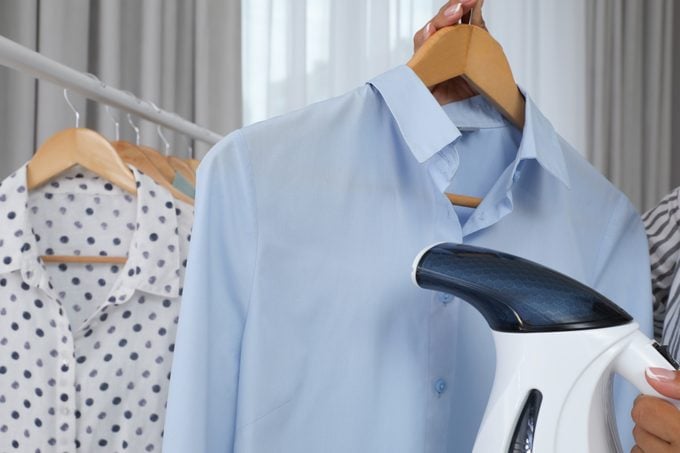
Generally speaking, fabric type will dictate whether you should use a steamer vs. iron, says Gagliardi. Prime candidates for steaming include delicate fabrics such as silk or chiffon, as well as fabrics like corduroy or velvet that could be crushed by a hot iron. Because a steamer releases a hot-water vapor to remove wrinkles without direct contact with the garment, it reduces the risk of the materials being burned or damaged.
A steamer also comes in handy when you need to quickly freshen up everyday garments or cover a large area (like curtains or bedding). Pateras notes that a travel steamer is a good investment if you often need to de-wrinkle clothes while on the road too. “You can’t always trust an iron in a hotel not to damage your clothes, and clothes coming out of a suitcase are more than likely wrinkled,” she says.
Pros of steamers
- You are less likely to burn or damage fabrics.
- You don’t need an ironing board.
- Their portability makes them good for travel, as well as small spaces like dorm rooms.
- They allow you to easily smooth large, harder-to-iron items like draperies.
Cons of steamers
- Steamers may not be as effective at producing crisp pleats, cuffs, creases and hems.
- It takes longer to get wrinkles out of stronger fabrics like cotton when using a steamer vs. iron.
When to use an iron
If you want a crisp, pressed finish on your shirt sleeves or work slacks, then an iron is the way to go. This is where an iron’s direct contact with the fabric is actually a net positive, allowing you to press pleats and create sharp folds that are difficult to achieve with a steamer.
The majority of textiles can withstand ironing. “Heavy-duty cottons and linens will respond well to the pressure, high heat and moisture an iron can provide, especially when the iron can also provide some steam,” says Gagliardi. That said, Pateras advises taking extra care when ironing silk and other delicate materials, as direct contact with the hot metal plate could burn and distort the fabric. You should never iron suede, leather, waxed fabrics and anything plastic for the same reason, she says. She recommends using low heat for fabrics like acrylic, lycra/spandex, rayon and nylon; medium heat for polyester, silk, wool and satin; and high heat for cotton, denim and linen.
Pros of irons
- They work better on heavier fabrics, like cotton, denim and canvas.
- Ironing can create sharp fold lines, including cuffs, pleats and creases.
- They often come with user-friendly features such as a retractable cord and automatic shut-off.
Cons of irons
- If you select the wrong temperature, you can melt or burn clothing.
- Their size makes them awkward to store, and an ironing board takes up extra space.
- They are more hazardous, introducing the risk of severe burns and tripping.
An important note before ironing or steaming clothes
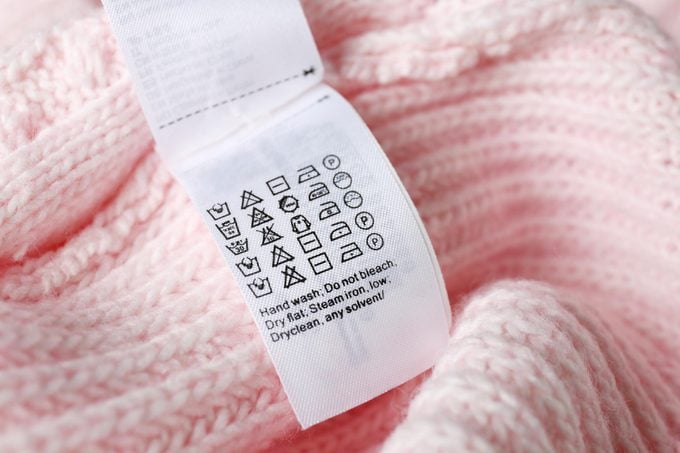
Before wielding your trusty iron or steamer, experts recommend double-checking your garment’s care label. The laundry symbols will indicate if an item should not be ironed, or if it can be ironed but shouldn’t use the iron’s steam function. An iron symbol with one, two or three dots inside the iron means that you can iron the item on low (one dot), medium (two dots) or high (three dots) heat, according to Pateras. An iron symbol with three dotted lines means that you should steam the item, while “X” symbols mean that no heat should be applied.
Once you know how to proceed, follow the instructions below for using a steamer vs. iron on your clothes.
How to steam clothes
Steaming clothes is often faster and more efficient than ironing them, but what you gain in time, you might lose in precision. “If you’re looking for a casual finish, then steaming is a good option,” Pateras says. With that in mind, she suggests these steps to steam fabric:
- Fill the steamer’s reservoir with distilled water.
- Add any necessary attachments based on the fabric.
- Turn on the steamer, and allow it to get to the desired heat.
- Hang up the item.
- Hold the steamer about one inch from the item. Any closer, and you could risk leaving water droplets on the item or burning the material with the hot steam.
- Move the steamer up and down while pulling the fabric tight. Heavier fabrics may require multiple passes with the steamer to get out severe wrinkles.
- When the wrinkles are gone, leave the item hanging and allow it to air-dry.
How to iron clothes
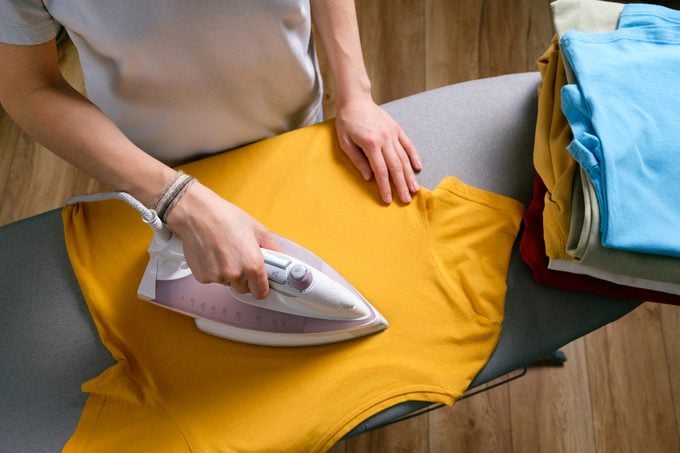
Expert tip: The best time to iron clothing is when it’s still a bit damp after machine washing. “You don’t need to get it all the way dry—just get any wrinkles out, and then hang the garment to finish drying completely,” Gagliardi says. “This is great if you like to air-dry your clothing to prevent shrinkage but don’t like the wrinkles that come from a high-speed spin cycle at the end of the wash.”
After pulling your damp garment out of the washing machine, Pateras recommends the following steps for ironing it:
- Assemble your ironing board on a flat surface.
- Fill the iron’s reservoir with distilled water.
- Turn on the iron, and set it to the appropriate temperature. If you don’t know the right temperature to use, check your garment’s laundry tags for instructions.
- If the item is delicate or printed, turn it inside out.
- When the iron is pre-heated, place the hot metal plate against the garment.
- Press out wrinkles, making sure the iron is always in motion to avoid scorching the item.
- Use the steam button to relax wrinkles even more.
- Hang up the item on a hanger or drying rack while it cools and sets.
Pro tip: If you waited to iron and your garment is no longer damp (see: my linen shirt at the bottom of the laundry pile), dampen it with water from a spray bottle for the same effect.
Precautions to take when using a steamer or iron
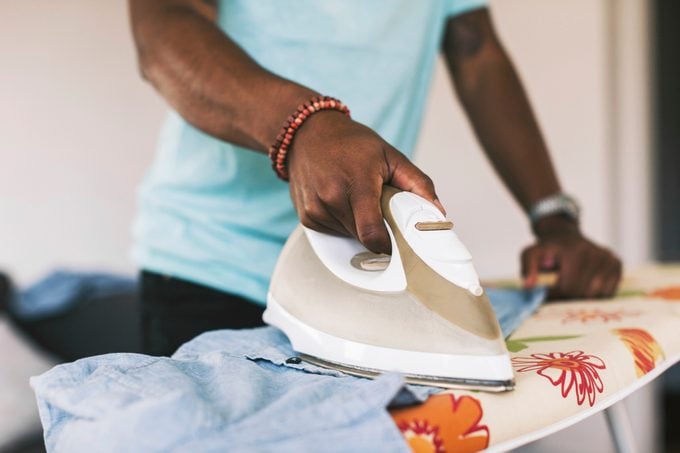
Regardless of whether you reach for a steamer or an iron, you should take proper precautions to keep your clothing—and yourself!—safe. Pateras recommends following these safety measures when steaming or ironing your clothes:
Personal safety
- Always hold the steamer or iron by the handle.
- To prevent burns, avoid putting your hand directly in front of the duct where the steam comes out. For the same reason, never place your hand on the flat metal part of an iron when it is turned on.
- Place your iron or steamer in an upright position (or its docking base, if you have a cordless) when not in use.
- Opt for an iron or steamer with an automatic shut-off function.
- Never leave your iron or steamer unattended. This can be a fire hazard and could also become dangerous to other people in the household if they don’t know it’s on.
- Unplug the iron and secure the cord before putting it away. Leaving the cord plugged in or loose could be a tripping hazard. Be sure the iron is completely cool before securing the cord for storage.
- Empty the water reservoir of an iron or steamer at the end of each use and before storing.
Clothing safety
- Check the laundry-care label on each item before beginning to iron or steam.
- Avoid using high heat on fabrics like acrylic, lycra/spandex, rayon and nylon, as they are more delicate and could be damaged by direct contact with heat.
- Always use distilled water in an iron or steamer. Tap water often contains minerals that can stain your clothing. If you do notice mineral buildup, clean your iron or else it could damage your clothes.
- Replace the water after each use. Like tap water, old water can develop deposits that end up on garments when ironing or steaming.
- Turn your delicates inside-out before ironing them.
What to look for when buying a steamer
Depending on how you intend to use a steamer, you should first look at the size. “If you want it for travel, get a compact one,” Gagliardi explains. If you don’t do much traveling, go larger—provided you have the space to store it. Larger steamers come with attachments like an anti-lint brush for removing hair and dust. They can also hold more water, allowing you to steam many items at once or larger items such as curtain and bedding, according to Pateras.
What to look for when buying an iron
Look for an iron that includes specific fiber types on the temperature gauge. “Nylon and polyester must be ironed at much lower temperatures than cotton or linen, and it helps to have the fiber types listed,” Gagliardi says. Pateras also suggests opting for an iron with safety features like a retractable cord and automatic shut-off.
If you have more wiggle room in your budget, Pateras highly recommends a multidirectional iron, which she calls “the Cadillac of irons.” It is made with two points at the top instead of one, which allows you to smooth out wrinkles by ironing in all directions quickly and easily, as well as reach tight spots like those around buttons and zippers. These irons also have seamless temperature adjustment settings, advanced steam features, larger and easier-to-fill reservoirs, and all the recommended safety features. While multidirectional irons are on the more expensive side, Pateras believes the price is “well worth it for those who iron more than once a year.”
FAQs
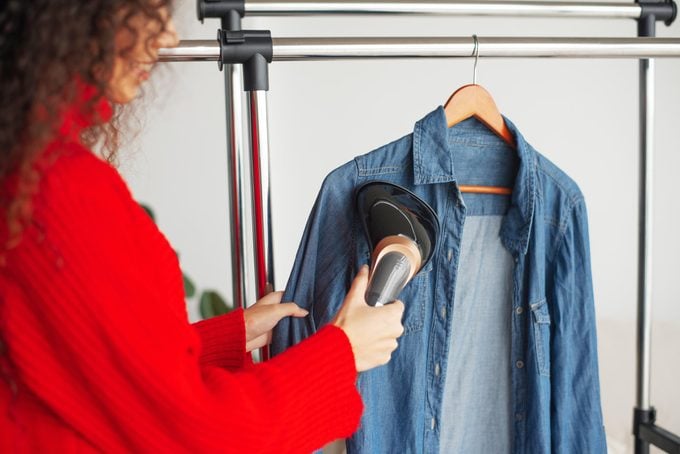
Is a steamer better than an iron?
When it comes to the steamer vs. iron debate, “one is not better than the other,” Pateras says. Ultimately, whether you use a steamer or an iron for your clothes depends on your needs and clothing type. Steamers are useful when you need to de-wrinkle a delicate dress or straighten out cumbersome items like curtains, but they can’t replace an iron if you want a crisp collar on your shirt or a crease in your pants.
Is it faster to steam clothes?
Not necessarily. Depending on your setup, both can be either fast or time-consuming, according to Pateras. Both steamers and irons require you to physically pull them out and wait for them to pre-heat. That said, you don’t need an ironing board if using a steamer, so you can save on setup time.
Can I steam my jeans?
By all means! Jeans can certainly benefit from an occasional steaming. Not only can steamers smooth out your jeans, but they can also soften them up after being washed.
Do steamers actually clean clothes?
Steamers do not clean clothes. “Think of it more like a refresh,” Pateras says. While steamers can remove wrinkles and creases in your garments, “only water and detergent can clean clothes, so it doesn’t take the place of that,” she explains.
Will an iron or steamer kill bacteria and viruses?
Since most germs are killed by a heat source above 167 degrees, using an iron or clothes steamer will sanitize the fabric. However, neither will remove everyday soils or stains. Ideally, you would wash your clothes first, then use one of the appliances as an additional sanitizing tool.
Why trust us
At Reader’s Digest, we’re committed to producing high-quality content by writers with expertise and experience in their field in consultation with relevant, qualified experts. For this piece, Brooke Nelson tapped her experience as a home and consumer-products writer, and then Mary Marlowe Leverette, a fabric-care, stain-removal and laundry expert with more than 40 years of industry experience, gave it a rigorous review to ensure that all information is accurate and offers the best possible advice to readers. We also relied on reputable primary sources, including LaundryTok expert Melissa Dilkes Pateras, author of A Dirty Guide to a Clean Home, and Mary Gagliardi, the in-house scientist and cleaning expert at Clorox. We verified all facts and data and backed them with credible sourcing, and we will revisit them over time to ensure they remain accurate and up to date. Read more about our team, our contributors and our editorial policies.
Sources:
- Mary Gagliardi, aka Dr. Laundry, in-house scientist and cleaning expert at Clorox; email interview, September 2021
- Melissa Dilkes Pateras, LaundryTok expert and author of A Dirty Guide to a Clean Home; email interview, Jan. 5, 2024

